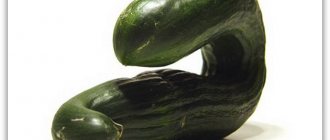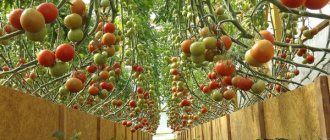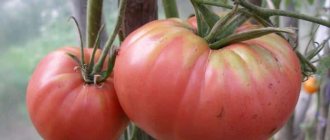Trellis for tomatoes
You can use various types of supports on your site or in a greenhouse: from wooden pegs to durable commercial stands made of polymer materials. Even at the beginning of the gardening season, long before planting seedlings, it is necessary to provide stands for tall tomatoes in the open ground. Although store-bought options look more aesthetically pleasing, it is more convenient to install a trellis made by yourself:
- it can be made in accordance with your desire and idea, and the master can also realize his own creative ideas;
- use pieces of reinforcement and timber material stored in utility rooms, saving on costs when purchasing a structure in a store;
- for installation in a greenhouse, select the ideal dimensions of the stand for supporting and gartering tomatoes.
Which option to choose is up to each gardener to decide for himself, taking into account the budget, materials available and the desire to build a trellis with his own hands.
Trellis for tomatoes
How to tie tomatoes on trellises
DIY support for a climbing rose
And now the trellis is ready, the planted seedlings begin to grow. There is no need to wait until the tomato begins to lean to the sides as it grows. As soon as it reaches the height of the first stretched cord of the trellis, you need to direct it towards the fastening, tying it lightly. The garter can be done in two ways:
- As they grow, tie the stems to a horizontally fixed wire;
- grab the plant from above, lowering the garter down.
You cannot pull the stem tightly, as it will grow not only in height, but also in thickness. It is also undesirable to pull several stems together. For full development, tomato culture needs free space.
For garters you need to use strong and wide ribbons and strips of fabric.
Tomato garter rope
Important! Fishing line, wire, or fabric with a rough texture should not be used. By cutting into the stem, these materials will cause the formation of wound surfaces through which pathogenic microorganisms can penetrate the plant.
The ideal option would be a soft cotton fabric with a width of 3 to 4 cm. Tying tomato bushes to one support makes it possible to prevent thickening, which tomatoes often suffer from.
Do I need to make trellises for tomatoes? Of what? How?
There are varieties of tall tomatoes. Do they need a trellis?
If yes, then how and from what to make it?
Svetlana 100
As a rule, tall tomatoes grow in greenhouses. It is most convenient to use small metal hooks made of thick wire (35-40 cm), we stick the sharp end near the tomato, and tie a strong rope to the hook. We attach the other end of the rope to the ceiling of the greenhouse. This is reusable a trellis that does not require periodic gartering of a growing tomato. We simply wrap it around a rope.
Low-growing tomatoes are more suitable for open ground, because tall ones do not have time to ripen all the tiers of tomatoes, cold weather sets in, and late blight attacks. Therefore, for tomatoes in open ground, you don’t have to bother with trellises, pegs are also suitable. Unless you save on stakes like this.
Irina Agapova
I do this as follows: I thoroughly dig in or hammer in a corner or piece of pipe with a sledgehammer at a distance of about 2 or 2.5 meters. I screw a wooden beam vertically to each pipe or corners. Then, at the same level, using a drill, I make 4 - 5 holes in each beam, which are located at a distance of 30 cm. from each other. Through these holes I stretch 4-5 rows of wire or a very strong (non-stretchable) cord and secure it well. Then I plant tomatoes in a row in front of this trellis, maintaining intervals. Shoots: I tie the central stem and side shoots with rags to these rows of wire or cord - as they grow higher and higher! I’ve been doing this for 30 years and I think it’s the most convenient!
Tju
In general, traditionally, if tall tomatoes are grown in open ground, in beds, then they are simply tied to strong stakes (such plants have a decent weight), which are prepared in advance.
dydySacha
If the variety is tall, then you just need to tie them up! Otherwise, all the fruits will lie on the soil, which will lead to their spoilage. If you have tomatoes under the greenhouse frame, then there are fewer problems with tying; you can tie them directly to it. If there is no greenhouse, you need to make a frame above each row, something like this:
angren
Those tomatoes that grow in open ground, if the varieties are tall, I simply tie them to wooden stakes. It happens that there are several heavy brushes on the bushes and they are held well, tied to stakes. But in the greenhouse I tie them to trellises, because the limited space of the greenhouse should not be taken up with stakes. I make a trellis from two supports and strong twine. When the bushes grow, they can be tied directly to the greenhouse frame.
How to garter
Every gardener should know that several options can be used for gartering tomatoes in a polycarbonate greenhouse, which is not available for growing tomatoes in open ground. The choice of a specific mounting method is determined taking into account the height of the plant and the yield. It is worth thinking about the fastening scheme even before the vegetable crop is planted. This will make caring for plants easier, and will also prevent damage to the roots and stems.
In the video, the garter is carried out:
Tying to a support
This mounting option should be used both for a film greenhouse and for a polycarbonate structure. Wood, metal or plastic stakes are used as support. They are installed near each bush, and the height of the pegs should correspond to the growth of an adult plant.
To the support
It is necessary to wrap a strip of fabric around the stem and secure it to a support. This garter option should be used when growing tomatoes that form medium-height tomato bushes.
Using wire frame
This option is perfect for compact bushes with a lot of fruit. It is necessary to use a metal mesh with large cells. Wrap it around the bush to make a wide pipe. Also dig lightly into the ground. It is necessary to attach both stems and branches laden with fruits to such a support.
To the wire frame
If necessary, the wire structure can be dismantled and moved to another location. The main disadvantage of this design is that certain difficulties arise during harvesting.
Linear fixation
This option can be considered simple and economical. It is used when it is necessary to grow a large number of bushes. The installation of the structure is carried out immediately after the construction of the greenhouse. Drive metal pipes on both sides of the bed and secure a rope to them.
To linear fixation
It should be stretched along the row. Tie the bushes to a rope at an equidistant distance. The disadvantage of this method is that it cannot be used for bushes that are too tall.
Trellis fixation
This method of tying is used in polycarbonate greenhouses when it is necessary to tie up tall tomato bushes with increased fruiting. Install metal supports along the edges of the greenhouse. Stretch ropes between them.
Every 30 cm they should form a strong mesh.
Secure the bushes with plastic clips. Fixation can also occur by threading the stems through a mesh.
Tomato garter with trellis fixation
Trellis are great for tying up spreading bushes that have fruiting shoots. Instead of ropes, you can use ready-made trellises made of wooden or plastic slats. The structure must be fastened securely so that it does not fall under the weight of the plants.
This information will help you understand how tomatoes are fertilized after planting in a greenhouse, and by what means.
But what to do when white spots appear on tomato seedlings, what the best means are, is indicated here.
It will also be useful to understand what are the most common diseases of tomatoes in open ground, and how to deal with them: //gidfermer.com/sadovodstvo/bolezni/tomatov-i-ix-lechenie.html
It may also be useful for you to learn about what tomatoes lack if the leaves curl.
Vertical trellis
This option is suitable for greenhouses that are used year-round. Also, a vertical trellis is ideal for tall bushes with pruned shoots on the sides. A rope must be attached near each plant. It will be fixed to the roof of the greenhouse.
Vertical trellis
With this method of gartering, you don’t have to worry about heavy bunches breaking and falling. To prevent injury to branches, it is necessary to use a wide, soft and strong rope.
Fixation on the mesh
In this case, it is necessary to stretch a metal or plastic mesh between the supports. It is best to use a mesh with large cells. Secure the branches and stems of tomatoes to it.
With mesh fixation
When the plant gains growth, it must be untied and secured at a new level.
It will also be interesting to learn more about existing methods of gartering tomatoes in open ground.
How to make a grape gazebo with your own hands, photo examples
Today, on personal plots you can see different types of gazebos: metal (welded and forged), wooden, stone, brick, glass and concrete. But nothing compares to the natural beauty of a living structure. A green gazebo entwined with grape vines, roses or formed from shrubs and trees is an absolute decoration of the garden and a wonderful place for a comfortable rest in the shade.
In this article we will dwell in detail on the topic of how to make living gazebos with your own hands, which grape varieties to choose, what other trees, plants and shrubs are suitable for a green oasis, how to form walls and a roof, and how to choose the right place for such a structure.
Supports for seedlings after planting in open ground
Gardeners most often opt for trellis structures, where the main material for installation is wood: the supports are posts and horizontal wooden slats. You need to know some points regarding how to position them correctly and extend their use:
Since the tree deteriorates faster, such tomato supports should be removed at the end of the season. Storing in a dry place will extend the life of the trellis. In addition, you need to cover them with paint, not for beauty, but to extend their service life. Moreover, next year the support can be installed in a different place, which complies with the rules of crop rotation.
Installing tomato stakes
Rows of tomatoes when grown on a trellis should be planted from north to south. With this planting, the bushes will be illuminated by the sun throughout the day. A good option is to plant seedlings in two rows with a staggered arrangement.
Important! The paths between the supports should be wide: the wider they are, the more nutrition the plants receive. And it will be easier to care for tomato bushes. When the seedlings are already planted in the ground, the slats are deepened by 20 cm with a sharp edge
A nail is hammered in at a distance of 20 cm from the top edge of the post; this will be the fastener for the transverse slats. A distance of no more than 2 meters is maintained between the posts. After a week or a week and a half, a garter is attached to horizontal slats.
When the seedlings are already planted in the ground, the slats are deepened by 20 cm with a sharp edge. A nail is driven in at a distance of 20 cm from the top edge on the post; this will fasten the transverse slats. A distance of no more than 2 meters is maintained between the posts. After a week or a week and a half, a garter is attached to horizontal slats.
trellises of different types make it easier to care for tomatoes, provide access to air and sunlight, since ultraviolet radiation kills infections and pathogens; tomatoes love hot weather and sun, so trellises and supports are placed in the direction from north to south, the sun will heat the bushes all day. Wide passages should be left between the supports to increase the feeding area and ease of care and harvesting; the condition of the trellises must be monitored by covering them with antiseptics and removing them, if possible, for the winter to extend their useful life; You should also tear off the lower leaves of tomato plants; in contact with the ground, they can be affected by diseases. To prevent the infection from spreading, they must be removed.
It is necessary to pick off the lower leaves of tomato plants
Although you can buy almost any kind of tomatoes in supermarkets and markets, many gardeners prefer to grow these nightshades themselves, investing their own energy. In constant search for improved methods of cultivation, more advanced devices (for example, trellises), they put a lot of effort into obtaining a decent harvest. This is why homemade tomatoes taste so much better.
» Tomatoes
This is the name of a specially made vertical support intended for plants in the garden or garden. Structurally, it can consist of wood or metal posts dug into the beds,
between which a plastic or metal mesh is stretched. It is allowed to replace the mesh with stuffed wooden planks. Today, such supports can be purchased in stores or made independently using available materials. In this review we will talk about making tomato trellises with your own hands and their design features.
In fact, tomatoes mounted on supports receive more oxygen, are illuminated by sunlight,
which is necessary for the formation of the ovary and ripening of the crop. At the same time, contact of leaves with moist soil is completely excluded, which helps prevent many diseases. During the formation period, the stem is tied up, then it is the turn of the branches with vegetables. Thus, the load on the main trunk of the bush is reduced.
Tomato plants on a trellis, grown in an open bed, feel better, increase yield, and can withstand unfavorable climate conditions. Their fruiting season is becoming longer.
In addition, the use of trellises provides its advantages in caring for tomato crops:
- you can move freely between the rows
; - the plants are well ventilated
and are easier to plant; - Harvesting
is made easier and fruits are not damaged.
The need for tying
Many tomato varieties have bushes with strong stems. But even for them, tying is a mandatory step in the growing process. Tall varieties, reaching a length of 2 m, especially need it. Low-growing tomatoes are tied less often. But if you refuse this procedure, caring for them becomes more complicated.
When tying, the stems and branches of the plant are secured to the support using rags, plastic loops, clothespins and other devices. Correctly carried out garter is beneficial for plants:
- it prevents stems and branches from breaking off under the weight of filling fruits;
- a vertically located bush is well illuminated by sunlight and ventilated;
- the likelihood of developing fungal diseases and viral infections is reduced;
- simplifies the care of beds;
- the filling fruits do not come into contact with the soil, therefore they are less susceptible to pests.
How to build a trellis for open ground?
One of the support options is shown in the photo (Fig. 2). To make a simple trellis from poles, you need to stick them into the soil at an angle and tie them in pairs, crossing the upper ends. Place another stick in the fork. Attach the cords to the horizontal pole. It is better to plant tall tomatoes in one row and form them into 1-2 stems, subsequently carefully removing all the shoots. Medium-sized tomatoes can be placed on both sides of the central pole and tied to inclined cords.
What types of trellises for cucumbers are there?
A lot of cucumber supports have been invented, this is confirmed by photos and descriptions of the structures. After this, we can discuss how to properly tie cucumbers in open ground.
We can talk about square (rectangular), pedestal-shaped trellises, in the form of a hut or tent.
Rectangular and hut type
The popularity of cucumbers can only be surpassed by tomatoes. Cucumber vines grow outdoors, in greenhouses, and at home.
The lashes grow up to 2-2.5 m long, they just need to cling to something PHOTO: samodelino.ru
Rectangular design PHOTO: 1teplica.com
The result is a vertical arrangement of the plant, because the vines rise upward. The main thing is to install a strong frame on which the wire will be placed in rows.
The hut or A-shaped structure is quite attractive in appearance, it is just as easy to use and, moreover, mobile. After the end of the season, you can put it in another place, for example, with overgrown flowers.
The height of the hut should not be less than 70-80 cm PHOTO: moefermerstvo.ru
There is also such a homemade design PHOTO: dachnye-sovety.ru
Round and arched
As an option, you can arrange round and arched options at your dacha. Arches are labor-intensive to manufacture, but the most aesthetically pleasing.
A round version made from unnecessary bicycle wheels PHOTO: orchardo.ruGarden bed with metal arches PHOTO: ogorod.ru
From the Gitter Mesh you can assemble such a convenient arch PHOTO: sad365.ru
Related article:
Trellis net for cucumbers stretched between the supports - ease of growing
A special net for tying cucumbers can be purchased at the store. It can be used both vertically and horizontally. The good thing about the cells is that it is very convenient for the tendrils to cling to them, and the vine itself chooses the direction of growth.
The mesh can be stretched onto a frame of any shape, turning it into a triangular, rectangular or any other structure.
Plastic mesh for gartering cucumbers PHOTO: moya-belarus.ru
The price of plastic mesh is low; you can immediately purchase the required footage, taking into account the grip on the frame. A wire stretched along the top of the support is suitable for fastening.
How to make a trellis for cucumbers with your own hands
Let's look at how to make a comfortable support for cucumbers with your own hands. Typically, summer residents rely on available materials and their own construction skills.
Simple rectangular
The basis of this design is timber up to 3 meters long. The usual height of the structure is 2 meters, which is exactly how tall the stems of cucumbers grow. Preparing the frame:
Corner supports are made from bars with a diameter of 50 millimeters, deepening them into the soil by 70-80 centimeters
The length of the bed and the distance between the corner supports is 5 meters. To prevent the structure from collapsing under the weight of the lashes, the corner posts are reinforced with guy wires. Intermediate columns are deepened by 50-60 centimeters, their thickness is less - 40 millimeters
After installing the frame, it is important to correctly tension the wire - 2 millimeters thick, the first row at a height of 20 centimeters, the next after 30-40 centimeters.. The top wire is thicker - at least 3 millimeters, since it is this that will hold most of the weight when the cucumbers trudge and sing
The top wire is thicker - at least 3 millimeters, since it is this wire that will hold most of the weight when the cucumbers begin to weave and sing.
From lumber
With a sufficient amount of high-quality lumber, you can make a beautiful lattice that will securely hold the vines and make it easier to grow cucumbers in open ground.
The work flow is as follows:
- Corner supports are dug in (the thickness of the timber is 50 millimeters, the depth is 70-80 centimeters). Strengthened with wire anchors.
- After 1-2 meters, additional racks are made, with a smaller diameter.
- A cross member is laid on top between the corner supports and secured rigidly, so the grill slats will be attached to it. If desired, you can make a drawing to immediately cut out the slats of the required size.
The size of the grid cells is 15 centimeters, the sufficient width of the slats is 3 millimeters. Such a pergola for cucumbers, with good woodworking skills, can become a decoration for your dacha.
From a metal profile
Metal structures are more durable; if fastened well, they will last a long time for gartering cucumber stems. The basis is made up of reinforcing bars more than 2 meters long. They are driven into the ground along the edges of the bed.
The easiest way to attach the top cross member from a pipe is to weld it with a welding machine. If this is not possible, twist the edges with wire or a thick cable. In this case, the frame will not be too reliable.
Between the supports, metal stakes are driven into the ground, to which the wire mesh will be attached. The pegs should be installed at a distance of 15 centimeters from each other. Wire is attached to the top pipe, side supports and stakes so that the cells are 15-20 centimeters in size.
Tip: all metal parts are painted and treated with anti-corrosion agents.
From the tire
A cucumber trellis, made with your own hands from scrap materials (tires and wheels), turns out to be small and convenient. A large diameter tire is cut lengthwise, laid on the ground, the middle for a bed of cucumbers and the tire is covered with prepared soil. A metal reinforcement is inserted into the center, onto which the wheel rim will be attached.
The ground is covered with burlap, in the slots of which cucumber seedlings are planted. When cold weather is possible, agrofibre is used for shelter. The wire is pulled through the holes for the spokes and the tire.
When the cucumbers entwine the device, it becomes like a canopy or hut with a round top. Such growing stands are mobile; next year they can be moved to another place, beautifully decorating the area.
From a special mesh
To create supports for cucumbers, several types of meshes are used:
- trellis;
- plastic made of polycarbonate;
- metal.
Each type has its own characteristics in fastening and caring for the material, which can be read in the instructions.
Installation rules:
- install reliable supports along the edges - pipes (metal or plastic), wooden poles;
- make intermediate posts for additional rigidity;
- on top, strengthen the rail into a spacer with a mesh pre-strung on it for attaching cucumber lashes;
- The sides of the mesh are attached to the supports with wire or twine, stretching without sagging.
The side supports require stretching and significant deepening.
What you will need
You will need timber or thick reinforcement rods to create a kind of support. Also, as additional elements, rope tension elements will be needed.
To understand how much material needs to be spent for each specific case, pay attention to the variety of tomatoes:
- For medium-height ones, that is, for semi-determinant ones, you will need to build a simple structure.
- For tall indeterminate tomatoes, a more complex structure will be needed that can also support the increased mass of the entire plant.
Consumables
For a simple design you need to take:
- Metal rods or wooden beams 2.5 m high. Of these, 0.5 m will go underground, and 2 m will rise above the ground.
- A ball of thick twine or cord.
- But for tall tomatoes, metal fittings, pipes or massive wooden beams are prepared, the height of which starts from 2.5 m to 3 m. In this case, 0.5 m is also dug into the ground.
- Also in this case it is better to use a polymer mesh rather than a rope.
Tools
Hammer, screwdriver, nails or screws for fixing elements. You will also need a shovel or album to form holes of sufficient depth. In addition, they stock up on a long tape measure and a level to form even vertical posts and horizontal crossbars.
Installing a trellis for tomatoes
It is imperative to take into account that the trellis being erected must be stable, otherwise it may destroy the planting if it collapses.
In the open ground
During installation, several main features are taken into account:
- When erecting a simple structure, the recess does not require reinforcement, since the 2 supports rest on each other and are fixed at the top point using a horizontal bar.
- If supports are installed frequently, then you don’t have to resort to additional rope elements to secure the plants. The garter is attached directly to them.
In the greenhouse
To erect a trellis for growing tomatoes in greenhouse conditions, take into account:
- When erecting a flat structure, in addition to the fact that the timber must be deepened by 0.5 m, fixation in the holes is strengthened using compacted sand.
- To make a reliable structure in a greenhouse, they use not a rope, but a polymer mesh. It is fixed between adjacent vertical posts, and then the branches of the plant are fixed to it.
Trellis net for tomatoes, cucumbers and peas
After the frame is installed, proceed to placing the trellis mesh. When placing a trellis on the open ground with your own hands, observe the practical requirements for it:
- choose a mesh with a cell size of 10x10 or 15x15cm;
- mesh material with high rigidity and strength;
- the cells should not be deformed under the weight of the plants;
- resistance of the material to moisture and sun;
- environmental cleanliness.
The easiest way to make a country trellis with your own hands is to buy a factory-made PVC product. We hasten to disappoint those who choose simplicity and speed: polyvinyl chloride mesh is short-lived, sags a lot, and quickly becomes unusable. It is better to make a trellis yourself, and we will tell you what materials it can be built from. The materials are quite affordable and can be purchased at any gardening, construction or hardware store.
Construction twine for trellis
Twine is often used in the country and not only for arranging trellises. The material is inexpensive and accessible, but it is one-year-old and quickly loses its properties over the season, and next year you will have to install a new trellis.
This has its advantages: fruit-bearing plants can be easily removed along with the twine. When organizing a trellis using rope, you do not need any special skills. First of all, you need to dig small pegs near the plants.
If we plan to install a frame made of wooden beams, we hammer nails onto the top bar, bending them in the form of hooks. In the case of a metal frame, we make hooks from wire. We cut the twine into pieces of 3 meters, attach the top to the hooks, and the bottom to the pegs. When the seedlings grow, we guide them along the ropes. You can make a cross trellis by cutting 5 meters of twine. This design is suitable for both peas and tomatoes. We fold the cut piece in half, fasten it to the hook, making one turn, and attach the ends to adjacent pegs.
Wooden slats for trellises
A lattice made of wooden slats is also a popular trellis design in the country. This system is used for cultivating cucumbers and tomatoes. When making it, take slats 20-30mm thick and fasten them with nails or self-tapping screws. They start by attaching the vertical partitions, then attach the horizontal parts so that their intersection forms cells. The result is a reliable design with a decorative effect.
Metal wire for trellis
Assembling a trellis using wire is a more labor-intensive and expensive process, but it turns out to be reliable and durable. Obviously, this is an overkill option for peas. Vertical rows can be made of soft wire. For horizontal rows, which increase the reliability of the fastening strips and create additional support, use steel wire with a diameter of 2-3mm.
In order to secure the wire to the frame, staples made of nails are installed on the stakes and strips. The staples are placed at the same distance as the stakes. The wire is cut into pieces and alternately stretched, first parallel to the ground, then perpendicular to the ground. Wires running vertically are wrapped around horizontal lines, forming cells of the required size.
Description of the trellis design - step-by-step instructions
Three columns are buried so that their height above the ground is three meters, and four meters apart from each other, in one row. The posts must be buried well so that they do not wobble. We connect the top of three posts with two four-meter slats. We nail it firmly on top.
Then, from top to bottom from the rail, after one meter, we stretch a thick wire and secure it with staples made of nails. On the outer posts we twist the ends of this wire around the post and secure them with staples. So - every meter. You get three stretched wires, and the bottom one should be 20 cm from the ground. The trellis frame is ready.
Now we take soft aluminum wire or any wire, cut pieces of 4.5 meters, and begin to braid from top to bottom. We fix the end of the wire on the rail, then twist it on the cross wires once at a time so that the thin wire does not move, and do this until the ground. After 20 cm, the next wire is twisted on the transverse ones again to the ground. We repeat this until the entire plane looks like a grid with identical cells.
You need to make six such panels of the same length and height. In the fall, on one side of the panel we dig a trench 60 cm wide and 50-60 cm deep. We place the soil next to it. Then we do this: take six parts of horse manure, six parts of mullein, one part of chicken, three parts of goat droppings, three parts of ash. Mix, fill the entire trench to the top, then cover with soil - you get a bed near the trellis.
Over the winter, the mixture will settle and rot. And in the spring we make a groove 10-15 cm deep throughout the entire bed, sow cucumbers and tall tomatoes through a trellis. That is, one row is cucumbers, the second is tomatoes, the next is cucumbers again. This should be done if we plant different varieties of tomatoes, so that they do not cross-pollinate.
When the seedlings grow up, we leave, for example, 30 tomato bushes, 40 cucumber plants at a distance of 15-20 cm from each other. So - a row of cucumbers, a row of tomatoes, we also alternate the next rows to preserve the varieties.
Care is as follows: guide the plants up the trellis and water them. To avoid loosening the beds, cover them with fine straw or dry leaves. From one tomato bush planted in this way, you can collect 1-1.5 buckets of good tomatoes. From the cucumber lash - 1 bucket of cucumbers.
Vegetables grown on a trellis are well ventilated and are very convenient to collect.
Description of trellis structures
A trellis is a lattice or rope tied to a peg, which representatives of the trellis use to cling to as they grow.
In some situations, only the presence of such a structure allows plants to form full-fledged lashes.
Today, summer residents are trying to ensure that the trellises perform not only a practical, but also an aesthetic function.
The photo of the trellis shows that it can be created from a variety of materials:
- metal;
- wood;
- plastic pipes;
- chain-links;
- woven wire mesh;
- plastic mesh.
The simplest option is a structure made of a strong stake driven into the ground and a rope tied to it.
The parameters of the trellises are significantly influenced by the type of plants and the method of forming the stems:
To form cucumber bushes, high arches and durable mesh or lattice structures are usually used.
Powerful supports of medium height are an excellent solution for tomatoes.
Raspberries only need a little help from trellises placed at the edges of the rows.
Clematis require a frequently spaced trellis.
A lattice made of wood or forged metal, a decorative mesh or a panel can serve as a trellis for roses.
In the greenhouse: DIY tomato trellis
The greenhouse uses trellis technology. It is possible both in polycarbonate greenhouses and in film greenhouses. It is not difficult to make such a system.
- At all ends of the bed, one and a half meter pegs are driven into the ground, which organizes the stability of the structure (profile or reinforcement);
- A trellis is placed between these pegs - it must be strong so that it is easy to support the weight of all the bushes; the bushes are tied to it;
- The tops of the bushes are attached with a rope, and then rise higher - as the plants grow, they will unravel along all the attached ropes, that is, there will be no need to tie them again.
The easiest way is to make trellises in a greenhouse from ropes or wires attached to a frame.
Less popular, but still possible, is the lattice garter method. This is a wire stretched between stakes in several rows, and at different heights. The lattice will be located perpendicular to the bed. It turns out that first the tomato branches will lie on a low wire, and then they will be fixed to the second one on the other side. The entire bush will be in a vertical position, but it will be clamped on both sides with wire. This method is otherwise called chess.
How to make a trellis with your own hands
Taking into account the simplicity of the design and the fact that available materials for its manufacture can always be found in any household, a homemade trellis is not without meaning. At the same time, it becomes possible to save money, space in the beds, and install supports not only for tomatoes, but also for other plants
Preparation of materials
The simplest version of a trellis, suitable for cultivating not very tall and highly branching tomato varieties, is a rope or wire stretched in several tiers between the posts. The structure should rise up to one and a half meters above the garden bed so that it is possible to tie up the plants as they grow. To install such a support you will need:
- supports made of metal or wood;
- wire or twine.
In addition, for more serious structures you may need:
- rags;
- polyethylene;
- polymer mesh;
- fastening material.
Manufacturing instructions
If you decide to grow tall tomato varieties, the height of the trellis should reach two meters so that the bushes can be formed correctly. In this case, a thick wire is stretched along the pillars, from which ropes intended for gartering are lowered to each plant. They can be made from soft rags or plastic film so as not to damage plant branches.
An excellent solution is to use a polymer mesh with large cells. To install such a trellis you need:
- install support posts;
- secure the net between them so that it does not touch the soil.
The advantage of such a trellis is that you can tie tomatoes of any variety to it - tall and short.
It should be added that such a mesh can be successfully used as a bed for plants in a polycarbonate greenhouse. You just need to attach it to the top of the greenhouse and hang it freely. Now you can tie branches and clusters of fruits to it at any height.
Another practical option is a design shaped like the letter “X”. Wooden poles are stuck into the beds at a certain angle, crossed, tied in pairs with twine or wire at the points of contact. A long crossbar is placed and fixed on top of such a hut. Ropes are hung on it to hold the plants.
Vertical support columns are dug in two to three meters to a depth of fifty to sixty centimeters. If a significant load is expected, the soil around the pillars should be reinforced with broken bricks, crushed stone or concrete. Wooden posts are treated with an antiseptic compound, painted or stained. This measure helps protect them from dampness and insects. Supports made of metal material must be primed.
Wooden elements are fastened with nails or self-tapping screws. Metal parts are connected with wire or welded. Twine can be stretched over the top to protect the plants with covering material in bad weather.
There are craftsmen who make three-dimensional structures from thin metal rods. This is very convenient for small areas. This trellis will help save space and will last a long time.
Trellis in a greenhouse
When growing tomatoes indoors, indeterminate varieties are most often used. They have unlimited growth and produce higher yields per unit area. But the height of the greenhouse rarely exceeds 2 m. Some gardeners arrange in the greenhouse a simple trellis made of wire stretched between posts, on which vertical cords are suspended for garter. When the bush reaches the wire, it is thrown over the support and is no longer tied up.
With prolonged fruiting, this method leads to breaking of the stem under the load of new ovaries. But experienced summer residents have improved the greenhouse trellis:
- At a height of 50-70 cm above the ground, a mesh tape is pulled between the pillars so that it forms a shelf. Tomatoes are planted along the trellis.
- When the seedlings need a garter, measure the cord. Its length is the height of the trellis (for example, 180 cm) and the additional length that a tomato bush can grow beyond this measurement. The excess cord must be wound onto a hand-made hook made of stiff wire.
- The hooks are hung on the trellis wire, the free ends of the cords are secured to the ground. Until the tomatoes reach the upper border of the trellis, they are tied up in the usual way. When the tops of the bushes begin to outgrow the height of the trellis, the rope, previously wound on a hook, is released 20-25 cm. The tomato stem is lowered onto a mesh stretched below, and the hook is moved along the wire. Do the same with the rest of the bushes.
See also
When is the best time to transplant tomato seedlings into pots?
Read
The advantage of the method is that the stems of tall tomatoes do not break under the weight of the fruit, and the gardener can continue to harvest until the onset of a persistent cold snap. In heated greenhouses, this method can significantly increase the tomato growing season.
Why tie it up at all?
With the help of proper tying, you can correctly form bushes. A correctly carried out procedure helps to increase productivity, faster ripening of fruits and prevent the death of the bush from one of the most common problems - a broken trunk.
Tying is necessary for medium and tall bushes. Tomato garter will help in solving the following problems:
- Watering the root zone of the bush, without damaging the tops and fruits. This is necessary to prevent sunburn.
- Formation of more ovaries.
- Protect the flowers and fruits of the plant from ants and other pests in the soil.
- Checking the plant to reduce the risk of rotting of the trunk and leaves from excess moisture.
- Strengthening the stem, taking the correct shape without bending.
- Prevent stems from becoming brittle under the weight of ripening fruits.
- Ensure uniform penetration of sunlight.
- Make the spraying procedure easier and more effective.
- Make the processes of weeding and pinching easier.
Options for trellis construction for vegetables in open ground
After installing the frame, you can begin making direct support for the “movement” of the shoots towards the sun.
The following requirements apply to trellis netting for vegetable crops:
- the optimal cell size is 10x10 or 15x15 cm;
- the material must be sufficiently strong and rigid;
- the cells should maintain their shape and not move to the side;
- resistance to sunlight and precipitation;
- environmental Safety.
The easiest and fastest way to make a trellis is to purchase a ready-made PVC mesh from a gardening store and attach it to an installed frame.
However, such a support will only last a few seasons. The mesh is prone to sagging, especially if the thickness is incorrect, which complicates harvesting. At the same time, making a reliable and durable trellis with your own hands is not so difficult.
Trellis made of construction twine
The use of twine in gardening is very common. Of course, after a season it will have to be changed, but this will not take much time and money.
A simple, but at the same time original support for cucumbers
To make a full-fledged trellis, you will need minimal construction skills. First, low pegs are dug in next to the seedling bushes. If the frame is wooden, then nails are driven into the top bar opposite the pegs installed below, bending the heads so as to form hooks. For a metal frame it is convenient to use pieces of rigid wire. Cut the twine 2.5 m long. Then tie one end of the twine to the hook and the other to the peg. The grown plants are then guided along the twine.
Another option: cut the twine into 5 m lengths, fold it in half and wrap the central part around a peg, and tie the two ends to adjacent nails. The result is a cross trellis with better conditions for shoot growth. In the fall, the twine can simply be cut off along with the withered lashes.
Trellis made of wooden slats
A trellis in the form of a wooden lattice is a very fast and low-cost way to make a support for tomatoes or cucumbers. The grille is assembled from slats 2-3 cm thick using screws or nails.
First, vertical slats are attached to the frame, and then horizontal ones, which divide the structure into cells. The result is a rather decorative and durable support.
Metal wire trellis
You can also make a strong and durable trellis from wire. Horizontal rows are made of steel wire with a thickness of 2 mm. It will serve as the main support to which the vertical threads will be screwed. For these purposes, aluminum or copper wire, which is corrosion-resistant and quite flexible, is better suited.
At the first stage of manufacturing, staples are made from nails on horizontal strips and vertical posts. The distance between the staples will correspond to the selected cell size. The prepared pieces of wire are first stretched horizontally and then vertically. To secure the cells, vertical threads need to be twisted around each horizontal wire. As an alternative, you can use ready-made metal mesh from an old fence.
Options for trellises, different support structures - photos
Below are photos of various DIY trellis designs.
Wooden posts for cucumbers Horizontal support for cucumbers from improvised means
Trellis for cucumbers on metal posts with coarse polymer mesh
Trellis for tomatoes - a vertical garter on a wire under the roof of the greenhouse
Trellis net for cucumbers in a greenhouse
DIY trellis for tomatoes in a greenhouse
How to make supports for seedlings from scrap materials? In one video I saw this design of a trellis for cucumbers.
Bamboo sticks must be stuck into the ground at an angle towards each other (like a hut). At the top they intersect with the letter X. Several pairs of bamboo supports are placed in a row. Another stick is inserted horizontally into the slingshots on top. At the junction points, the sticks are fastened to each other with wire or strong twine - this gives stability to the entire structure. A twine is attached to a horizontal support, with the help of which the lashes of cucumbers are fixed to the supports.
The trellis is made of bamboo, with additional intermediate horizontal crossbars added.
Tomato support hut made of bamboo sticks
Trellis, photo
The design of the trellis made of wooden slats is interesting. It is not only functional, but also very decorative.
Here's a very ingenious solution - old used hockey sticks came in handy. In my opinion, it’s not difficult to do it yourself, but it turned out very well.
Support and at the same time shelter (greenhouse) for cucumbers made of plastic pipes Support for cucumbers on a high bed
How to properly tie tomatoes or cucumbers on a trellis?
Watch the video. You will be taught how to properly tie knots when growing vegetables vertically.
When growing on a trellis, a trellis net is very convenient not only for gardeners, but also for plants. In addition, this is a great relief for those who make the trellis themselves. It can be different - with small or large cells, thicker for large plants or thread-like for delicate flower climbing plants.
A trellis, a vertical support, can be used not only for cucumbers and tomatoes, but also for beans, peas, raspberries, blackberries, and various flowers. With its help, you can significantly save the usable space of your garden. And the harvest increases. A do-it-yourself trellis is an opportunity to take into account the slightest desires and growing conditions of any gardener.











